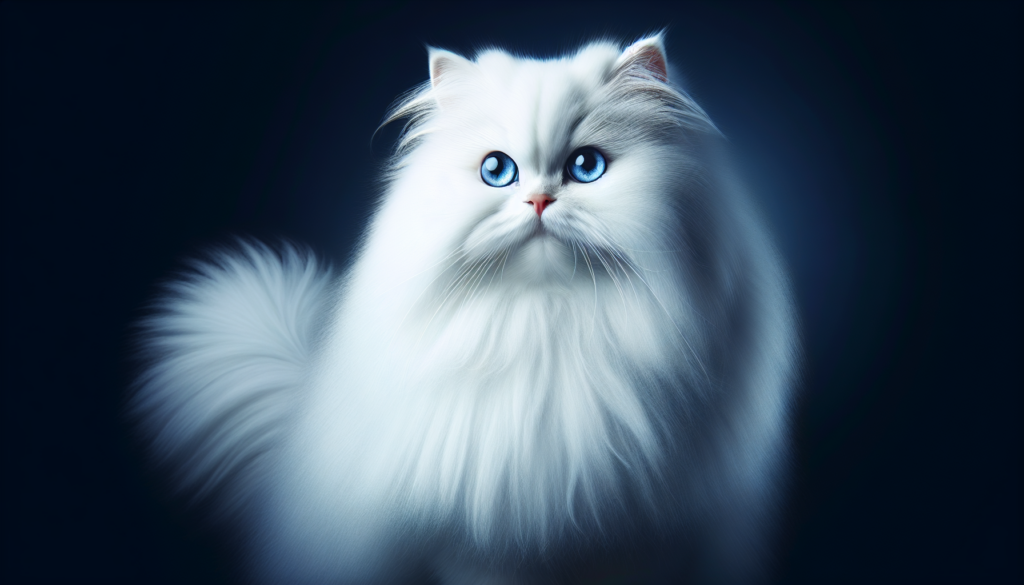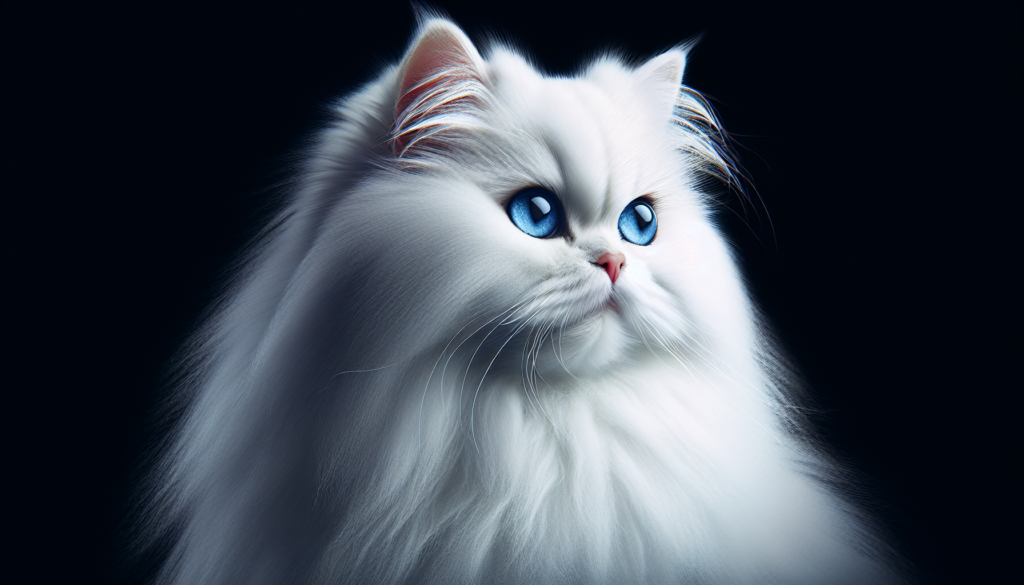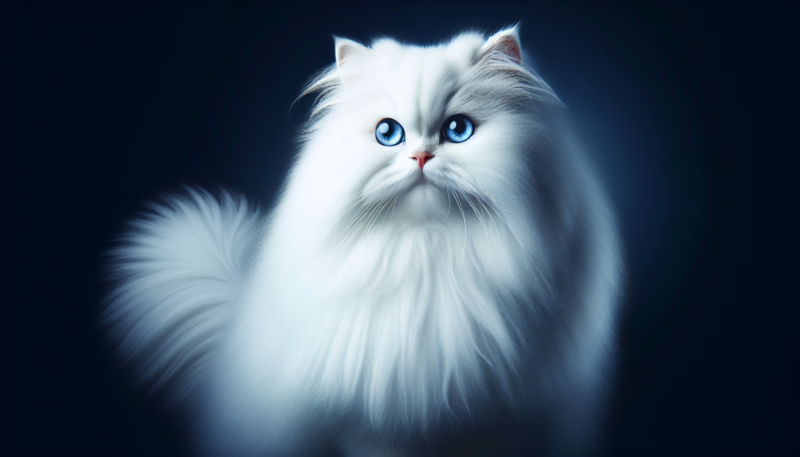Ah, the elegant and enchanting White Persian Cat. With its luscious, snow-white fur and stunning blue eyes, this breed exudes beauty and grace. Known for its charming and gentle nature, the White Persian Cat has captured the hearts of cat lovers around the world. Whether it’s lounging on a sunlit windowsill or delicately grooming itself, this majestic feline never fails to captivate with its ethereal presence. Embark on a journey into the world of the White Persian Cat and discover the allure and allure of this magnificent creature.
Appearance
Coat color
The White Persian cat is known for its beautiful, pure white coat color. The white fur is often vibrant and eye-catching, making these cats truly stand out. The coat is typically long and dense, adding to the regal and elegant appearance of the breed. The white color is a result of a genetic mutation that affects the production of pigment in the fur.
Fur texture
The fur of the White Persian cat is long and luxurious, with a soft and silky texture. It tends to be thick and dense, requiring regular grooming to prevent matting and tangling. The fur can range from wavy to straight, but it is typically silky and flowing, giving the cat a graceful and elegant look.
Eye color
One of the most striking features of the White Persian cat is its eye color. These cats often have beautiful blue eyes, which provide a captivating contrast against their white fur. The blue eyes can have various shades, ranging from light and icy to deep and vivid. The combination of the white fur and blue eyes creates a stunning and mesmerizing look.
Facial structure
The White Persian cat has a distinctive facial structure characterized by a round face and a short, broad nose. The face often has a sweet and innocent expression, with large, round eyes and small, rounded ears. The rounded face and wide-set eyes contribute to the breed’s adorable and endearing appearance, making them irresistible to cat lovers.
Body type
White Persian cats have a medium to large body size and a sturdy build. They have a round and compact body, with a broad chest and a solid muscular frame. The legs are short and strong, supporting the cat’s balanced and agile movements. The overall body shape is well proportioned, giving the White Persian cat a graceful and elegant presence.
History
Origins
The White Persian cat is believed to have originated in ancient Persia, which is now modern-day Iran. These cats were highly regarded and cherished by Persian nobility and were often kept as prized companions. They were treasured for their stunning appearance and gentle temperament. Over time, the breed made its way to Europe and gained recognition worldwide.
Popularity
The White Persian cat quickly gained popularity due to its striking appearance and gentle nature. It became a sought-after pet among cat enthusiasts and was frequently seen in high society households. The breed’s popularity soared in the late 1800s, when cat shows and exhibitions first emerged. The White Persian cat’s stunning appearance and regal demeanor made it a show-stopping competitor and a breed of choice for many cat lovers.
Breed standards
The White Persian cat, like all cat breeds, has specific breed standards that dictate its ideal physical characteristics. These standards include details about coat color, structure, and other unique features that define the breed. The standards ensure that the breed’s beauty and type are maintained and that cats from reputable breeders closely adhere to the desired breed characteristics.

Characteristics
Temperament
White Persian cats are known for their calm and gentle temperament. They are typically laid-back and enjoy a relaxed lifestyle. These cats are often described as affectionate and loving, forming strong bonds with their owners. They thrive on attention and companionship, making them great pets for people seeking a loyal and devoted feline companion.
Personality traits
The White Persian cat is known for its sweet and kind personality. They are generally known to be friendly, gentle, and patient, making them excellent companions for families with children or other pets. These cats enjoy a peaceful environment, so they are not particularly fond of loud noises or chaos. They are often found lounging on the sofa or perched in a sunny spot, enjoying a quiet and serene existence.
Grooming needs
With their long and dense fur, White Persian cats require regular grooming to keep their coat in top condition. Daily brushing is recommended to prevent mats and keep the fur tangle-free. Additionally, occasional baths may be necessary to maintain the cleanliness of the thick coat. Regular eye cleaning is also essential to prevent tear staining, a common issue in this breed.
Health issues
Like any other breed, White Persian cats may be prone to certain health issues. Some of the common health problems observed in this breed include respiratory difficulties, dental issues, and eye-related problems such as corneal ulcers and tear duct blockage. Regular veterinary check-ups and proper care can help detect and manage these potential health concerns effectively.
Life expectancy
The average life expectancy of a White Persian cat is typically around 12 to 16 years. However, with proper care, a healthy diet, regular exercise, and regular veterinary check-ups, some cats may live even longer. Providing a safe and nurturing environment along with adequate healthcare can greatly contribute to promoting a longer and healthier life for these beloved pets.
Care and Maintenance
Feeding
To keep your White Persian cat healthy, provide a balanced and nutritious diet. High-quality cat food that is specifically formulated for the nutritional needs of adult cats is recommended. Be cautious to avoid overfeeding, as obesity can be a concern for this breed. Always ensure that fresh water is available for your cat at all times.
Exercise
While White Persian cats are generally not as energetic as some other breeds, regular exercise is still important to maintain their overall health and prevent obesity. Engaging in play sessions with interactive toys or providing climbing structures can help your cat stay mentally stimulated and physically active. However, it is crucial to ensure that your cat’s exercise routine matches its individual activity level and physical capabilities.
Grooming
As mentioned earlier, White Persian cats have long and dense fur that requires regular grooming. Daily brushing with a soft-bristle brush or comb is essential to prevent tangles and mats. Pay special attention to areas prone to tangling, such as behind the ears and under the armpits. Regular bathing may also be necessary to keep the coat clean and healthy.
Healthcare
Regular veterinary check-ups are essential to ensure your White Persian cat’s overall health and well-being. Vaccinations, parasite prevention, and dental care should be provided as recommended by your veterinarian. Attention to the cat’s eyes, ears, and teeth is particularly important due to common issues associated with these areas in the breed. Early detection and timely treatment can help prevent any potential health problems from escalating.
Environmental needs
White Persian cats thrive in a calm and peaceful environment. They prefer a secure and safe indoor space where they can relax and enjoy their surroundings. Creating cozy spots, providing comfortable bedding, and offering vertical spaces for climbing and observation can greatly enrich their living environment. It is important to ensure that the indoor space is safe and free from potential hazards.

Training and Socialization
Socialization
Proper socialization plays a crucial role in a White Persian cat’s development. Introducing them to various people, animals, and environments from a young age helps them become well-adjusted and confident cats. Positive experiences during socialization can contribute to their friendly and outgoing nature, making it easier for them to adapt to new situations throughout their life.
Basic commands
While White Persian cats may not be as responsive to training as some other breeds, they can still learn basic commands such as “sit” and “stay” with patience and positive reinforcement. Offering treats and praise as rewards for desired behaviors can motivate them to participate in training sessions and learn new commands.
House training
House training a White Persian cat often involves providing a clean litter box and encouraging them to use it consistently. It is important to maintain cleanliness by scooping the litter box daily and changing the litter regularly. Positive reinforcement, such as treats and praise, can be used to encourage the desired behavior and reinforce good litter box habits.
Behavioral issues
While White Persian cats are generally well-behaved and peaceful, they are susceptible to behavioral issues if not properly stimulated and engaged. Boredom can lead to destructive behaviors, such as scratching furniture or excessive meowing. Providing appropriate toys, scratching posts, and interactive playtime can help prevent these issues and keep your cat mentally and physically stimulated.
Positive reinforcement
White Persian cats respond well to positive reinforcement training methods. Rewarding desired behaviors with treats, praise, or playtime can motivate them to continue displaying those behaviors. It is important to avoid punishment or harsh training methods, as this breed is sensitive and may become fearful or anxious as a result.
Living Environment
Indoor vs Outdoor
White Persian cats are best suited for an indoor living environment. Due to their pure white fur and potential health issues, they are more vulnerable to the elements and outdoor hazards. An indoor space provides a safe and controlled environment where they can thrive and remain protected from potential dangers.
Suitable households
White Persian cats are a great choice for households that value a calm and peaceful atmosphere. They are well-suited for individuals or families who are looking for a gentle and affectionate companion. However, it is important to consider the individual needs of the cat and ensure that the household can provide the necessary care and attention to meet those needs.
Safety considerations
Creating a safe living environment for White Persian cats involves considering potential hazards. Ensuring windows and balconies are securely screened or protected prevents accidental falls. Removing toxic plants, securing loose cords, and keeping chemicals and toxic substances out of reach are also important safety measures. Regularly checking for potential hazards and making necessary adjustments can help keep your cat safe and secure.
Famous White Persian Cats
Choupette
Choupette is a White Persian cat that gained fame as the pet and muse of the late fashion designer Karl Lagerfeld. She became a social media sensation and even had her own book published. Choupette’s stunning looks and glamorous lifestyle captured the hearts of many cat lovers around the world.
Snowball
Snowball was the White Persian cat featured in the iconic horror film “The Exorcist.” Known for her piercing blue eyes and haunting presence, she left a lasting impression on audiences and became an unforgettable symbol of the film.
Marshmallow
Marshmallow is an Instagram-famous White Persian cat known for his adorable round face and luxurious white coat. With a large following on social media, Marshmallow has amassed a fan base that can’t resist his irresistible charm.
Crystal
Crystal is a White Persian cat owned by the famous fashion designer, Donatella Versace. Often seen accompanying Versace at various events, Crystal has become a symbol of elegance and style.
Breeding and Ownership
Breeding guidelines
Breeding White Persian cats should be responsibly undertaken by knowledgeable and reputable breeders. It is important to ensure that proper genetic testing is conducted to minimize the risk of passing on inheritable health problems. Breeders should adhere to breed standards and prioritize the health and well-being of the cats.
Finding a reputable breeder
When seeking a White Persian cat, it is crucial to find a reputable breeder who prioritizes the breed’s welfare. Look for breeders who are knowledgeable about breed standards, health testing, and socialization practices. Visiting the breeder’s facility, asking for references, and observing the cats’ living conditions can help ensure that you are acquiring a healthy and well-cared-for cat.
Adopting from a shelter
Adopting a White Persian cat from a shelter can be a wonderful option for those looking to give a deserving cat a loving home. Shelters often have a variety of cats available for adoption, including purebred Persians. Through adoption, you can provide a second chance to a cat in need and experience the joy of giving them a forever home.
Costs of ownership
Owning a White Persian cat comes with various costs, including initial expenses for adoption or purchase, routine veterinary care, food, grooming supplies, and toys. Additionally, unexpected costs, such as emergency veterinary care, should be considered. It is important to budget for these expenses to ensure that you can provide the necessary care and attention throughout your cat’s life.
Myths and Misconceptions
Albino misconception
Contrary to popular belief, White Persian cats are not albinos. Albinism involves a complete absence of pigment, resulting in pink or red eyes. White Persians may have blue eyes, but this is due to genetic factors unrelated to albinism.
Difficulty seeing in the dark
While White Persian cats may not have the same visual acuity as some other breeds, they are not completely blind in the dark. Their vision is adapted to low-light conditions, allowing them to navigate relatively well in darker environments.
High maintenance breed
While White Persian cats do require regular grooming and maintenance, they are not necessarily high maintenance overall. With proper care, including regular brushing, grooming, and veterinary check-ups, their needs can be effectively managed. The rewards of owning a White Persian cat, such as their beauty and affectionate nature, make the grooming efforts worthwhile.
Conclusion
Whether you’re captivated by their stunning white coat, mesmerized by their beautiful blue eyes, or simply drawn to their calm and gentle nature, the White Persian cat is a breed that offers both beauty and companionship. With their regal appearance, affectionate personality, and low-key temperament, they make wonderful pets for individuals and families alike. While their long, silky fur may require regular grooming, the joy of having a White Persian cat as a loyal and loving companion far outweighs the maintenance involved. So, if you’re ready to welcome a majestic and elegant feline into your home, consider the White Persian cat and prepare to be enchanted by its enchanting charm.
